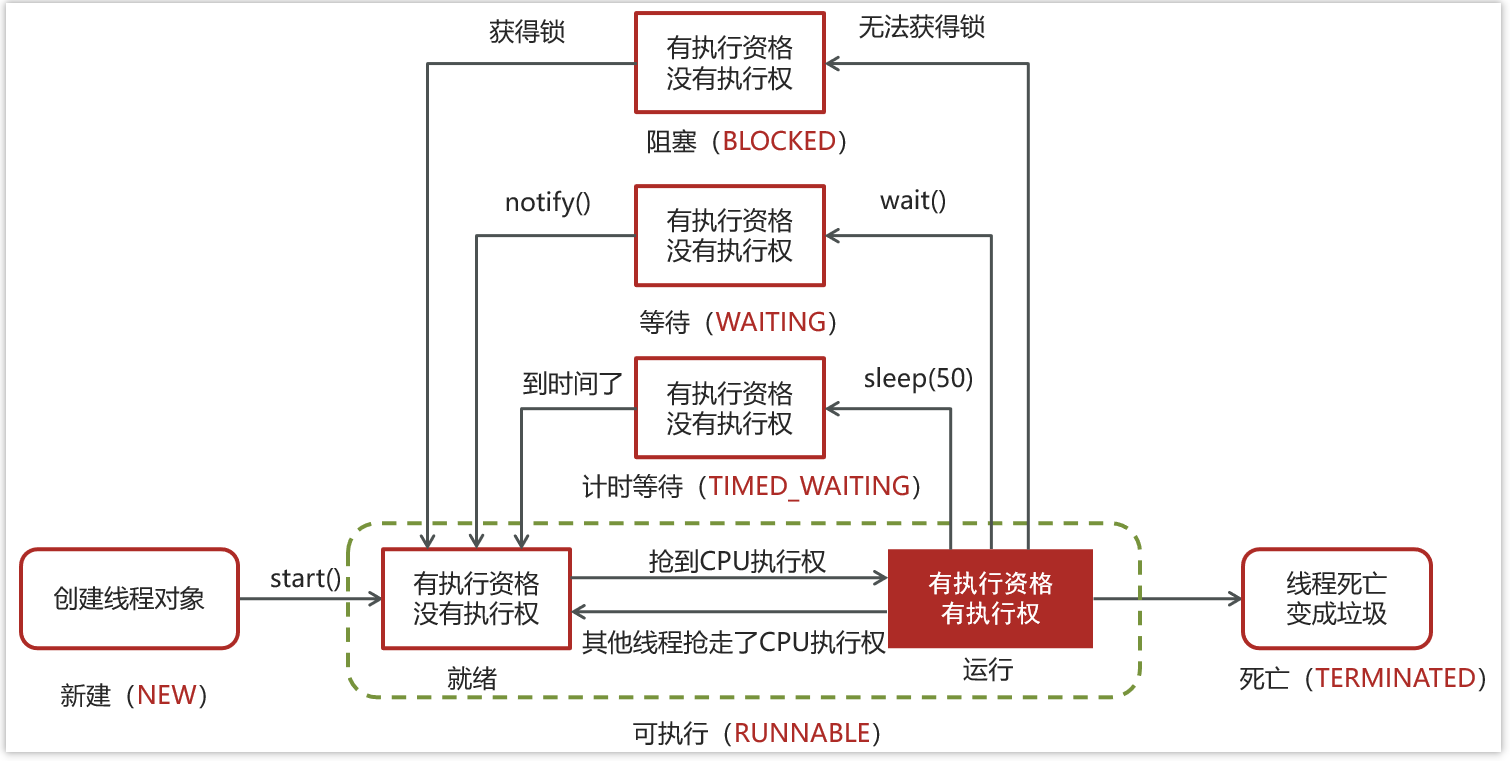
线程基础
一、创建线程的四种方式
参考回答:
共有四种方式可以创建线程,分别是:继承Thread类、实现runnable接口、实现Callable接口、线程池创建线程
详细创建方式参考下面代码:
① 继承Thread类
public class MyThread extends Thread {
@Override
public void run() {
System.out.println("MyThread...run...");
}
public static void main(String[] args) {
// 创建MyThread对象
MyThread t1 = new MyThread() ;
MyThread t2 = new MyThread() ;
// 调用start方法启动线程
t1.start();
t2.start();
}
}② 实现runnable接口
public class MyRunnable implements Runnable{
@Override
public void run() {
System.out.println("MyRunnable...run...");
}
public static void main(String[] args) {
// 创建MyRunnable对象
MyRunnable mr = new MyRunnable() ;
// 创建Thread对象
Thread t1 = new Thread(mr) ;
Thread t2 = new Thread(mr) ;
// 调用start方法启动线程
t1.start();
t2.start();
}
}③ 实现Callable接口
public class MyCallable implements Callable<String> {
@Override
public String call() throws Exception {
System.out.println("MyCallable...call...");
return "OK";
}
public static void main(String[] args) throws ExecutionException, InterruptedException {
// 创建MyCallable对象
MyCallable mc = new MyCallable() ;
// 创建F
FutureTask<String> ft = new FutureTask<String>(mc) ;
// 创建Thread对象
Thread t1 = new Thread(ft) ;
Thread t2 = new Thread(ft) ;
// 调用start方法启动线程
t1.start();
// 调用ft的get方法获取执行结果
String result = ft.get();
// 输出
System.out.println(result);
}
}④ 线程池创建线程
public class MyExecutors implements Runnable{
@Override
public void run() {
System.out.println("MyRunnable...run...");
}
public static void main(String[] args) {
// 创建线程池对象
ExecutorService threadPool = Executors.newFixedThreadPool(3);
threadPool.submit(new MyExecutors()) ;
// 关闭线程池
threadPool.shutdown();
}
}二、runnable 和 callable 的区别
Runnable 接口run方法没有返回值;Callable接口call方法有返回值,是个泛型,和Future、FutureTask配合可以用来获取异步执行的结果
Callalbe接口支持返回执行结果,需要调用FutureTask.get()得到,此方法会阻塞主进程的继续往下执行,如果不调用不会阻塞。
Callable接口的call()方法允许抛出异常;而Runnable接口的run()方法的异常只能在内部消化,不能继续上抛
三、线程的 run()和 start()的区别
start(): 用来启动线程,通过该线程调用run方法执行run方法中所定义的逻辑代码。start方法只能被调用一次。
run(): 封装了要被线程执行的代码,可以被调用多次。
四、线程包括哪些状态,状态之间是如何变化的
线程的状态可以参考JDK中的Thread类中的枚举State
public enum State {
/**
* 尚未启动的线程的线程状态
*/
NEW,
/**
* 可运行线程的线程状态。处于可运行状态的线程正在 Java 虚拟机中执行,但它可能正在等待来自
* 操作系统的其他资源,例如处理器。
*/
RUNNABLE,
/**
* 线程阻塞等待监视器锁的线程状态。处于阻塞状态的线程正在等待监视器锁进入同步块/方法或在调
* 用Object.wait后重新进入同步块/方法。
*/
BLOCKED,
/**
* 等待线程的线程状态。由于调用以下方法之一,线程处于等待状态:
* Object.wait没有超时
* 没有超时的Thread.join
* LockSupport.park
* 处于等待状态的线程正在等待另一个线程执行特定操作。
* 例如,一个对对象调用Object.wait()的线程正在等待另一个线程对该对象调用Object.notify()
* 或Object.notifyAll() 。已调用Thread.join()的线程正在等待指定线程终止。
*/
WAITING,
/**
* 具有指定等待时间的等待线程的线程状态。由于以指定的正等待时间调用以下方法之一,线程处于定
* 时等待状态:
* Thread.sleep
* Object.wait超时
* Thread.join超时
* LockSupport.parkNanos
* LockSupport.parkUntil
* </ul>
*/
TIMED_WAITING,
/**
* 已终止线程的线程状态。线程已完成执行
*/
TERMINATED;
}状态之间的转换
 分别是
分别是
新建 NEW
当一个线程对象被创建,但还未调用 start 方法时处于新建状态
此时未与操作系统底层线程关联
可运行 RUNNABLE
调用了 start 方法,就会由新建进入可运行
此时与底层线程关联,由操作系统调度执行
终结 TERMINATED
线程内代码已经执行完毕,由可运行进入终结
此时会取消与底层线程关联
阻塞 BLOCKED
当获取锁失败后,由可运行进入 Monitor 的阻塞队列阻塞,此时不占用 cpu 时间
当持锁线程释放锁时,会按照一定规则唤醒阻塞队列中的阻塞线程,唤醒后的线程进入可运行状态
等待 WAITING
当获取锁成功后,但由于条件不满足,调用了 wait() 方法,此时从可运行状态释放锁进入 Monitor 等待集合等待,同样不占用 cpu 时间
当其它持锁线程调用 notify() 或 notifyAll() 方法,会按照一定规则唤醒等待集合中的等待线程,恢复为可运行状态
有时限等待 TIME_WAITING
当获取锁成功后,但由于条件不满足,调用了 wait(long) 方法,此时从可运行状态释放锁进入 Monitor 等待集合进行有时限等待,同样不占用 cpu 时间
当其它持锁线程调用 notify() 或 notifyAll() 方法,会按照一定规则唤醒等待集合中的有时限等待线程,恢复为可运行状态,并重新去竞争锁
如果等待超时,也会从有时限等待状态恢复为可运行状态,并重新去竞争锁
还有一种情况是调用 sleep(long) 方法也会从可运行状态进入有时限等待状态,但与 Monitor 无关,不需要主动唤醒,超时时间到自然恢复为可运行状态
五、新建 T1、T2、T3 三个线程,如何保证它们按顺序执行?
在多线程中有多种方法让线程按特定顺序执行,你可以用线程类的join()方法在一个线程中启动另一个线程,另外一个线程完成该线程继续执行。
代码举例:
为了确保三个线程的顺序你应该先启动最后一个(T3调用T2,T2调用T1),这样T1就会先完成而T3最后完成
public class JoinTest {
public static void main(String[] args) {
// 创建线程对象
Thread t1 = new Thread(() -> {
System.out.println("t1");
}) ;
Thread t2 = new Thread(() -> {
try {
t1.join(); // 加入线程t1,只有t1线程执行完毕以后,再次执行该线程
} catch (InterruptedException e) {
e.printStackTrace();
}
System.out.println("t2");
}) ;
Thread t3 = new Thread(() -> {
try {
t2.join(); // 加入线程t2,只有t2线程执行完毕以后,再次执行该线程
} catch (InterruptedException e) {
e.printStackTrace();
}
System.out.println("t3");
}) ;
// 启动线程
t1.start();
t2.start();
t3.start();
}
}六、notify()和 notifyAll()有什么区别?
notifyAll:唤醒所有wait的线程
notify:只随机唤醒一个 wait 线程
package com.itheima.basic;
public class WaitNotify {
static boolean flag = false;
static Object lock = new Object();
public static void main(String[] args) {
Thread t1 = new Thread(() -> {
synchronized (lock){
while (!flag){
System.out.println(Thread.currentThread().getName()+"...wating...");
try {
lock.wait();
} catch (InterruptedException e) {
e.printStackTrace();
}
}
System.out.println(Thread.currentThread().getName()+"...flag is true");
}
});
Thread t2 = new Thread(() -> {
synchronized (lock){
while (!flag){
System.out.println(Thread.currentThread().getName()+"...wating...");
try {
lock.wait();
} catch (InterruptedException e) {
e.printStackTrace();
}
}
System.out.println(Thread.currentThread().getName()+"...flag is true");
}
});
Thread t3 = new Thread(() -> {
synchronized (lock) {
System.out.println(Thread.currentThread().getName() + " hold lock");
lock.notifyAll();
flag = true;
try {
Thread.sleep(2000);
} catch (InterruptedException e) {
e.printStackTrace();
}
}
});
t1.start();
t2.start();
t3.start();
}
}结果:
Thread-0...wating...
Thread-1...wating...
Thread-2 hold lock
Thread-1...flag is true
Thread-0...flag is true
七、在 java 中 wait 和 sleep 方法的不同?
参考回答:
共同点
wait() ,wait(long) 和 sleep(long) 的效果都是让当前线程暂时放弃 CPU 的使用权,进入阻塞状态
不同点
方法归属不同
sleep(long) 是 Thread 的静态方法
而 wait(),wait(long) 都是 Object 的成员方法,每个对象都有
醒来时机不同
执行 sleep(long) 和 wait(long) 的线程都会在等待相应毫秒后醒来
wait(long) 和 wait() 还可以被 notify 唤醒,wait() 如果不唤醒就一直等下去
它们都可以被打断唤醒
锁特性不同(重点)
wait 方法的调用必须先获取 wait 对象的锁,而 sleep 则无此限制
wait 方法执行后会释放对象锁,允许其它线程获得该对象锁(我放弃 cpu,但你们还可以用)
而 sleep 如果在 synchronized 代码块中执行,并不会释放对象锁(我放弃 cpu,你们也用不了)
代码示例:
public class WaitSleepCase {
static final Object LOCK = new Object();
public static void main(String[] args) throws InterruptedException {
sleeping();
}
private static void illegalWait() throws InterruptedException {
LOCK.wait();
}
private static void waiting() throws InterruptedException {
Thread t1 = new Thread(() -> {
synchronized (LOCK) {
try {
get("t").debug("waiting...");
LOCK.wait(5000L);
} catch (InterruptedException e) {
get("t").debug("interrupted...");
e.printStackTrace();
}
}
}, "t1");
t1.start();
Thread.sleep(100);
synchronized (LOCK) {
main.debug("other...");
}
}
private static void sleeping() throws InterruptedException {
Thread t1 = new Thread(() -> {
synchronized (LOCK) {
try {
get("t").debug("sleeping...");
Thread.sleep(5000L);
} catch (InterruptedException e) {
get("t").debug("interrupted...");
e.printStackTrace();
}
}
}, "t1");
t1.start();
Thread.sleep(100);
synchronized (LOCK) {
main.debug("other...");
}
}
}八、如何停止一个正在运行的线程?
参考回答:
有三种方式可以停止线程
使用退出标志,使线程正常退出,也就是当run方法完成后线程终止
使用stop方法强行终止(不推荐,方法已作废)
使用interrupt方法中断线程
代码参考如下:
① 使用退出标志,使线程正常退出。
public class MyInterrupt1 extends Thread {
volatile boolean flag = false ; // 线程执行的退出标记
@Override
public void run() {
while(!flag) {
System.out.println("MyThread...run...");
try {
Thread.sleep(3000);
} catch (InterruptedException e) {
e.printStackTrace();
}
}
}
public static void main(String[] args) throws InterruptedException {
// 创建MyThread对象
MyInterrupt1 t1 = new MyInterrupt1() ;
t1.start();
// 主线程休眠6秒
Thread.sleep(6000);
// 更改标记为true
t1.flag = true ;
}
}② 使用stop方法强行终止
public class MyInterrupt2 extends Thread {
volatile boolean flag = false ; // 线程执行的退出标记
@Override
public void run() {
while(!flag) {
System.out.println("MyThread...run...");
try {
Thread.sleep(3000);
} catch (InterruptedException e) {
e.printStackTrace();
}
}
}
public static void main(String[] args) throws InterruptedException {
// 创建MyThread对象
MyInterrupt2 t1 = new MyInterrupt2() ;
t1.start();
// 主线程休眠2秒
Thread.sleep(6000);
// 调用stop方法
t1.stop();
}
}③ 使用interrupt方法中断线程。
package com.itheima.basic;
public class MyInterrupt3 {
public static void main(String[] args) throws InterruptedException {
//1.打断阻塞的线程
/*Thread t1 = new Thread(()->{
System.out.println("t1 正在运行...");
try {
Thread.sleep(5000);
} catch (InterruptedException e) {
e.printStackTrace();
}
}, "t1");
t1.start();
Thread.sleep(500);
t1.interrupt();
System.out.println(t1.isInterrupted());*/
//2.打断正常的线程
Thread t2 = new Thread(()->{
while(true) {
Thread current = Thread.currentThread();
boolean interrupted = current.isInterrupted();
if(interrupted) {
System.out.println("打断状态:"+interrupted);
break;
}
}
}, "t2");
t2.start();
Thread.sleep(500);
// t2.interrupt();
}
}
九、守护线程
1.概况
在Java中,线程分为两种主要类型:用户线程和守护线程(Daemon Thread)。
用户线程(User Thread):
用户线程是程序的主要执行线程,当用户线程存在时,JVM 不会退出。主线程是一个典型的用户线程。
守护线程(Daemon Thread):
守护线程是一种在后台提供服务的线程,它的存在并不阻止程序的终止。当所有的用户线程结束时,守护线程会被自动终止,即它的生命周期会随着用户线程的结束而结束。
守护线程通常被用于执行一些辅助性质的任务,例如垃圾回收、内存管理等。JVM 中的垃圾回收器就是一个典型的守护线程。
2.用处
在Java中,通过setDaemon(boolean on)方法可以将一个线程设置为守护线程。例如:
A和B之间有一条网络连接,可以用守护线程来进行发送心跳,一旦A和B连接断开,非守护线程就结束了,守护线程(也就是心跳没有必要再发送了)也刚好断开。
public static void main(String[] args) {
Thread t = new Thread(() -> {
Thread innerThread = new Thread(() -> {
try {
while (true) {
System.out.println("Do some thing for health check.");
Thread.sleep(1_000);
}
} catch (InterruptedException e) {
e.printStackTrace();
}
});
// innerThread.setDaemon(true);
innerThread.start();
try {
Thread.sleep(1_000);
System.out.println("T thread finish done.");
} catch (InterruptedException e) {
e.printStackTrace();
}
});
//t.setDaemon(true);
t.start();
}
/*
设置该线程为守护线程必须在启动它之前。如果t.start()之后,再t.setDaemon(true);
会抛出IllegalThreadStateException
*/输出结果:
Do some thing for health check.
Do some thing for health check.
T thread finish done. //此时main线程已经结束,但是由于innerThread还在发送心跳,应用不会关闭
Do some thing for health check.
Do some thing for health check.
Do some thing for health check.
Do some thing for health check.
3.补充
当JVM启动后,实际有多个线程,但是至少有一个非守护线程(比如main线程)。

Finalizer:GC守护线程
RMI:Java自带的远程方法调用(秋招面试,有个面试官问过)
Monitor :是一个守护线程,负责监听一些操作,也在main线程组中
其它:我用的是IDEA,其它的应该是IDEA的线程,比如鼠标监听啥的。

